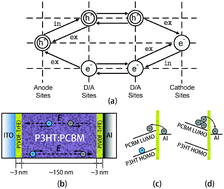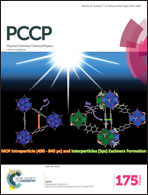Numerical simulations of the role of a ferroelectric polymer interfacial layer in organic solar cells
Abstract
A Pauli master equation method is adopted for the simulation of polymer bulk heterojunction (BHJ) solar cells with vinylidene fluoride–trifluoroethylene copolymer (P(VDF–TrFE)) films as interfacial layers. According to previous reports, using highly crystalline P(VDF–TrFE) films as interfacial layers can highly enhance the efficiency of polymer BHJ solar cells, and possible mechanisms for the enhancement by two different groups were given as the dipole induced permanent internal electric field or simply the electrode improvement which implied that the origin is the barrier lowering effect. The correlation between the appearance of S-shaped current density–voltage (J–V) characteristics and the energy barrier is studied first, and then further results indicate that the previous electrode improvement model provides a consistent explanation for the origin of performance enhancement due to the insertion of polarized P(VDF–TrFE) interfacial layers. Moreover, the phenomenon of an increase of the internal electric field observed before can be attributed to better contact conditions which help reduce the bimolecular recombination rate. Comparatively speaking, the electrode improvement model can give a more rational explanation for the origin of performance enhancement experimentally found. In contrast, the dipole induced permanent internal electric field model was not complete enough.


 Please wait while we load your content...
Please wait while we load your content...